Answered step by step
Verified Expert Solution
Question
1 Approved Answer
Features and Functionalities:for java programe 1 . Classes and Objects: Define multiple classes such as Device, Room, SmartHome, User, and EnergyConsumption. Each class represents a
Features and Functionalities:for java programe
Classes and Objects:
Define multiple classes such as Device, Room, SmartHome, User, and EnergyConsumption.
Each class represents a distinct entity with relevant attributes and behaviors.
Constructors:
Implement parameterized constructors in each class to initialize objects with specific values.
Utilize default constructors where necessary.
Encapsulation:
Enforce encapsulation by making class fields private.
Provide public getter and setter methods to access and modify the private fields.
Association:
Demonstrate association through relationships between classes. For example, a Room can contain multiple Devices, and a User can manage multiple Rooms.
Implement both onetomany and manytomany associations.
Inheritance:
Create a hierarchical structure where classes inherit common properties and behaviors from parent classes. For example, SmartLight and SmartThermostat can inherit from a base class Device.
Polymorphism:
Implement polymorphism through method overloading and overriding.
Utilize dynamic method dispatch to handle method calls at runtime.
Abstract Classes and Interfaces:
Define abstract classes such as Appliance with abstract methods that are implemented by concrete subclasses SmartLight SmartThermostat, and SmartLock
Create interfaces like Controllable for devices that can be controlled remotely and Monitorable for devices that report status or usage data.
MultiThreading:
Integrate multithreading to handle concurrent operations, such as monitoring device status and processing user commands simultaneously.
Implement thread synchronization to manage shared resources and avoid data inconsistencies.
Detailed Component Breakdown:
Device Class:
Attributes: deviceId, deviceName, status.
Abstract Methods: turnOn turnOff getStatus
Demonstrates encapsulation and serves as a base class for specific device types.
SmartLight and SmartThermostat classes can inherit from a base class Device and override the abstract methods.
Room Class:
Attributes: roomId, roomName, devices.
Methods: addDevice removeDevice getRoomDetails
Showcases association with the Device class.
SmartHome Class:
Attributes: homeId, homeName, rooms, users.
Methods: addRoom removeRoom addUser removeUser getHomeDetails
Acts as a composite entity, aggregating multiple Room instances and associated users.
User Class:
Attributes: userId, userName, managedRooms.
Methods: addRoom removeRoom controlDevice
Demonstrates user management and association with the Room class.
EnergyConsumption Class:
Attributes: deviceId, energyUsed, timestamp.
Methods: logEnergyUsage getEnergyReport
Implements the Monitorable interface to provide energy usage data.
MultiThreading Implementation:
Classes DeviceMonitor and UserCommandProcessor implement Runnable to handle concurrent monitoring of device status and processing of user commands.
Use of synchronized blocksmethods to ensure thread safety.
In the Smart Home Management System project, the SmartHomeManagementSystem class will serve as the main class containing the main method. This class will be responsible for initializing the system, creating instances of the various components eg devices, rooms, users and providing a commandline interface or a basic GUI for interacting with the smart home system.
Here is an example of how the SmartHomeManagementSystem class might look:
Initialization:
A new SmartHome object named mySmartHome is created.
Room objects for the living room and kitchen are created and added to the smart home.
Device Creation and Assignment:
SmartLight and SmartThermostat objects are created.
These devices are added to the appropriate rooms.
User Creation and Room Assignment:
A User object is created and assigned to manage the created rooms.
User Interactions:
The user performs actions like turning on a light and setting the thermostat temperature.
MultiThreading:
A DeviceMonitor object is created and run in a separate thread to continuously monitor device statuses.
A UserCommandProcessor object is created and run in a separate thread to handle user commands concurrently.
Completion:
The main thread waits for the monitoring and command processing threads to complete using join
The final state of the smart home is printed to the console.
Exception Handling
Please add try catch Block to at least main method to handle Exceptions. Please try to use specific type of Exceptions which can occur during different operations. Please ensure that the methods who do not handle Exception, implements thorws Exception.
Bonus Develop a GUI using Java Swing or JavaFX to allow users to interact with the system, providing input and receiving output in a userfriendly manner.
Step by Step Solution
There are 3 Steps involved in it
Step: 1

Get Instant Access to Expert-Tailored Solutions
See step-by-step solutions with expert insights and AI powered tools for academic success
Step: 2

Step: 3

Ace Your Homework with AI
Get the answers you need in no time with our AI-driven, step-by-step assistance
Get Started


